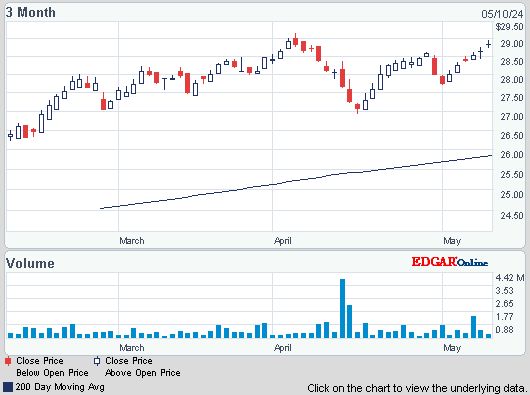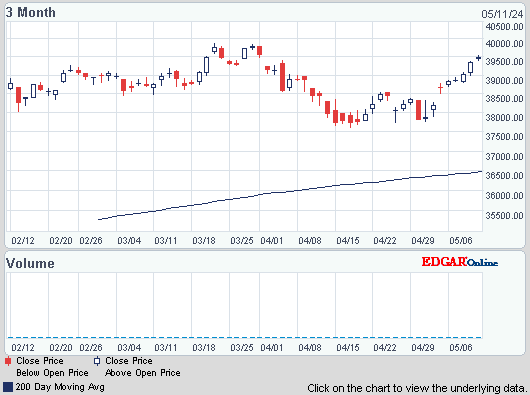Dow slid 14, decliners ahead of advancers 2-1 & NAZ was off 13. The MLP index slipped a fraction in the 237s & the REIT index dropped 4 to the 263s. Junk bond funds were mixed to lower & Treasury yields moved higher, spurred by the Fed;s announcement that it would reduce its asset-purchase program. Oil rose
for a 2nd day after the Fed said it will reduce
stimulus as the nation’s economic outlook improves & as US
fuel consumption increased. Gold sank again, going below the important 1200 support level.
AMJ (Alerian MLP Index tracking fund)

Jobless claims climbed 10K to 379K last week, the most since the end of Mar according to the Labor Dept. The forecast called for a decrease to 336K. The 4 week average is more meaningful during the holiday season. The 4 week average of claims climbed to 344K, the highest in a month, from 330K in the prior week. Unemployment that fell last month to a 5 year low & progress in hiring helped prompt the Federal Reserve to reduce their bond buying yesterday. Gains in payrolls are also helping lift consumer confidence. The number continuing to receive jobless benefits increased by 94K to 2.88M in the latest week. The continuing claims figure does not include the number of Americans receiving extended benefits under federal programs. Those job-seekers rose by 125K to 1.37M & these payments are set to lapse at year’s end as Dems failed to extend the assistance before the House adjourned. The unemployment rate among people eligible for benefits increased to 2.2% in the latest week from 2.1% in the prior period.
Photo: Bloomberg
Sales of previously owned home declined for the 3rd consecutive month in Nov to the lowest level of the year as rising mortgage rates & a limited supply of properties discouraged buyers. Purchases dropped 4.3% to a 4.9M annual rate, the National Association of Realtors reported. The forecast called for the pace to slow to 5.02M. Still, the group projects 2013 will be the best year for the industry in 7 years, with an estimated 5.1M properties sold. Rising prices & borrowing costs have put homes out of reach for many first-time buyers & a gov shutdown in Oct may have delayed some purchase decisions. At the same time, builder confidence has picked up along with new construction, signaling gains in housing will be sustained. The median price of an existing home rose 9.4% to $196K from $179K last year. The number of existing properties for sale dropped 0.9% from Oct to a 2.09M rate, the fewest since Mar. At the current pace, it would take 5.1 months to sell those houses, compared to 4.9 months in the previous 3 months. Inventory was up 5% from a year earlier. Purchases of single-family homes decreased 3.8% to an annual rate of 4.32M. The sales pace of multifamily properties including condominiums dropped 7.9% to 580K. Sales of distressed property, including foreclosures, accounted for 14% of the total last month, unchanged from Oct.
The index of US leading indicators rose more than forecast in Nov, a sign the economic expansion may gain traction in the coming months. The Conference Board’s index, a gauge of the outlook for the next 3-6 months, increased 0.8% last month after rising 0.1% in Oct. The forecast called for an advance of 0.7%. Rising stock prices, a firming housing market & gains in the labor market are helping to boost spending among households, whose balance sheets have improved over the last 4 years. Fading fiscal drag from federal spending cuts in 2014 may also lift growth, supporting demand as the recovery accelerates. 8 of the 10 components contributed to the increase, led by a drop in jobless claims & a widening spread between short- and long-term interest rates. “November data reflect a US economy that is expanding modestly,” the Conference Board, said. The index has been “signaling for some time that the economy is developing forward momentum, and will continue to strengthen through early 2014.” The Conference Board’s index of coincident indicators, a gauge of current economic activity, rose 0.4%, the biggest advance since Feb, after a 0.1% gain in the prior month.
Leading Indicators in U.S. Rose More Than Forecast in November
Traders need time to think things over after yesterday's surge. Among other things, the move by the Fed to reduce bond purchases signals an end to the low interest rate era is approaching. There is even talk that it might start raising interest rates as soon as late 2014. That's something this bull market is more sensitive to than economic data which has been bland for months. Dow remains up a massive 3K (23%) YTD, which will be one of its best years ever.
Dow Jones Industrials

AMJ (Alerian MLP Index tracking fund)
Treasury yields:
U.S. 3-month |
0.06% | |
U.S. 2-year |
0.36% | |
U.S. 10-year |
2.93% |
| CLF14.NYM | ...Crude Oil Jan 14 | ...98.39 | (0.6%) |
| GCF14.CMX | ...Gold Jan 14 | .....1,195.10 | (3.3%) |
Jobless claims climbed 10K to 379K last week, the most since the end of Mar according to the Labor Dept. The forecast called for a decrease to 336K. The 4 week average is more meaningful during the holiday season. The 4 week average of claims climbed to 344K, the highest in a month, from 330K in the prior week. Unemployment that fell last month to a 5 year low & progress in hiring helped prompt the Federal Reserve to reduce their bond buying yesterday. Gains in payrolls are also helping lift consumer confidence. The number continuing to receive jobless benefits increased by 94K to 2.88M in the latest week. The continuing claims figure does not include the number of Americans receiving extended benefits under federal programs. Those job-seekers rose by 125K to 1.37M & these payments are set to lapse at year’s end as Dems failed to extend the assistance before the House adjourned. The unemployment rate among people eligible for benefits increased to 2.2% in the latest week from 2.1% in the prior period.
Sales of previously owned home declined for the 3rd consecutive month in Nov to the lowest level of the year as rising mortgage rates & a limited supply of properties discouraged buyers. Purchases dropped 4.3% to a 4.9M annual rate, the National Association of Realtors reported. The forecast called for the pace to slow to 5.02M. Still, the group projects 2013 will be the best year for the industry in 7 years, with an estimated 5.1M properties sold. Rising prices & borrowing costs have put homes out of reach for many first-time buyers & a gov shutdown in Oct may have delayed some purchase decisions. At the same time, builder confidence has picked up along with new construction, signaling gains in housing will be sustained. The median price of an existing home rose 9.4% to $196K from $179K last year. The number of existing properties for sale dropped 0.9% from Oct to a 2.09M rate, the fewest since Mar. At the current pace, it would take 5.1 months to sell those houses, compared to 4.9 months in the previous 3 months. Inventory was up 5% from a year earlier. Purchases of single-family homes decreased 3.8% to an annual rate of 4.32M. The sales pace of multifamily properties including condominiums dropped 7.9% to 580K. Sales of distressed property, including foreclosures, accounted for 14% of the total last month, unchanged from Oct.
The index of US leading indicators rose more than forecast in Nov, a sign the economic expansion may gain traction in the coming months. The Conference Board’s index, a gauge of the outlook for the next 3-6 months, increased 0.8% last month after rising 0.1% in Oct. The forecast called for an advance of 0.7%. Rising stock prices, a firming housing market & gains in the labor market are helping to boost spending among households, whose balance sheets have improved over the last 4 years. Fading fiscal drag from federal spending cuts in 2014 may also lift growth, supporting demand as the recovery accelerates. 8 of the 10 components contributed to the increase, led by a drop in jobless claims & a widening spread between short- and long-term interest rates. “November data reflect a US economy that is expanding modestly,” the Conference Board, said. The index has been “signaling for some time that the economy is developing forward momentum, and will continue to strengthen through early 2014.” The Conference Board’s index of coincident indicators, a gauge of current economic activity, rose 0.4%, the biggest advance since Feb, after a 0.1% gain in the prior month.
Leading Indicators in U.S. Rose More Than Forecast in November
Traders need time to think things over after yesterday's surge. Among other things, the move by the Fed to reduce bond purchases signals an end to the low interest rate era is approaching. There is even talk that it might start raising interest rates as soon as late 2014. That's something this bull market is more sensitive to than economic data which has been bland for months. Dow remains up a massive 3K (23%) YTD, which will be one of its best years ever.
Dow Jones Industrials











No comments:
Post a Comment